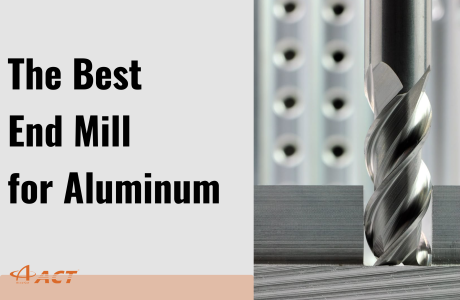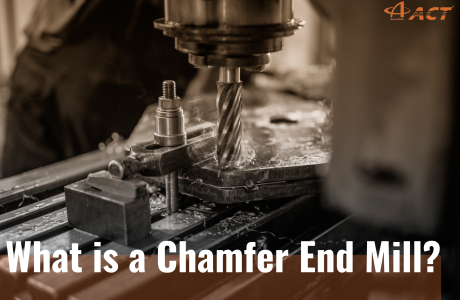Ever found yourself staring at a catalog of end mills, wondering which one to choose for your CNC machine? You are not alone, navigating the vast selection of end mills can be daunting, especially for beginners.
In our beginner's guide to CNC end mills, we'll walk you through the differences between various types of end mills and offer practical tips to select the perfect tool for your machining projects.
What is a CNC end mill?
CNC end mills are rotary cutting tools used in computer numerical control (CNC) machines for milling operations to remove material from a workpiece.
They are commonly used to create slots, pockets, contours, and various shapes on materials such as metal, wood, plastic, and composites.
CNC end mills come in various shapes, sizes, and materials, each designed for specific types of cutting, milling, and finishing tasks.
CNC End Mill Applications
CNC end mills can be used in various industries and applications requiring precision machining. Some common applications include:
- Metalworking: Manufacturing parts for automotive, aerospace, and machinery industries.
- Woodworking: Crafting furniture, cabinetry, and decorative wood products.
- Mold making: Producing molds for plastic injection molding or metal casting processes.
- Prototyping: Creating prototypes and models in research and development settings
- DIY projects: Enthusiasts and hobbyists often use end mills for creating custom parts or artwork with materials like metal, wood, or plastic.

What types of CNC machines use CNC end mills?
CNC end mills can be used in a variety of CNC machines, each designed for specific applications and materials.
CNC Milling Machines
- Vertical CNC Milling Machines: These machines have a vertically oriented spindle that holds the end mill. They are versatile and widely used for a variety of milling operations, including cutting, drilling, and contouring.
- Horizontal CNC Milling Machines: These machines have a horizontally oriented spindle. They are often used for more complex cutting operations and can handle larger workpieces more efficiently.
CNC Routers
Used primarily for cutting and shaping wood, plastics, composites, and softer metals. CNC routers are popular in woodworking, sign making, and other industries requiring intricate designs.
CNC Lathes
Although CNC lathes primarily use turning tools, they can be equipped with milling capabilities and use end mills for specific operations like milling flat surfaces or drilling holes on cylindrical parts.
CNC Machining Centers
These are advanced CNC milling machines capable of performing multiple operations, including milling, drilling, tapping, and boring, all in a single setup. They often feature automatic tool changers for increased efficiency.
CNC Engraving Machines
Specialized for detailed engraving work, these machines can use small-diameter end mills to create intricate designs on metals, plastics, and other materials.
Differences between end mill and drill bits?
End mills and drill bits may seem similar at first glance, but they serve distinct purposes in machining operations.
End mills can move up, down, and sideways to cut material from the workpiece; they are primarily used to create features such as slots, pockets, and complex contours.
Drill bits are designed specifically for drilling holes into a workpiece. They create cylindrical holes by rotating and applying axial force to penetrate the material.
CNC End Mill Overview
Side View
- Diameter
- Flute Length
- Helix Angle
- Overall Length
- Shank
- Shank Diameter

Top View
- Flute
- Cutting Edge
- End Teeth Gash
- Center Hole
- Undercut Face
- Heel

How to choose the right end mill for your project?
Selecting the right end mill for your project is crucial for achieving optimal results. Here's a comprehensive guide to help you navigate the selection process:
CNC End Mill Size
When choosing an cnc end mill, the length is determined by the depth it needs to penetrate into the material.
For example, if you're milling a deep pocket, you'll want to make sure the flute length is long enough to fully reach the bottom without the shank getting in the way or hitting the spindle.
But that doesn't mean you should just go for the longest end mill you can find. The more an end mill sticks out, the less rigid it becomes , making it more likely to bend and deflect.
This can lead to poor surface finishes, increased vibration and chatter, or damage to the tool or workpiece.
So, it's best to choose an end mill with a length that's just long enough for the cutting depth you need while keeping the tool as short as possible to maintain stability and precision.
CNC End Mill Cutting Diameter
Larger end mills can remove more material in a single pass , making them efficient for roughing operations where a lot of material needs to be cut away quickly.
On the other hand, smaller end mills provide better precision and are ideal for for detail work and finishing operations.
Here's a breakdown of different diameter ranges and their applications:
Micro End Mills
- Diameter Range: 1/200” to 1/8” (0.127mm to 3.175mm)
- Applications:
- Microfluidics channel milling.
- Detail engraving on small parts.
- Intricate milling for medical devices or electronics.

Miniature End Mills
- Diameter Range: 1/8” to 1/2” (3.175mm to 12.7mm)
- Applications:
- Roughing applications in large workpieces.
- Machining of large molds, dies, and parts.
- Shipbuilding, aerospace, automotive structural components.
Large End Mills
- Diameter Range: 1” to 2” (25.4mm to 50.8mm) and sometimes even larger
- Applications:
- Roughing applications in large workpieces.
- Machining of large molds, dies, and parts.
- Shipbuilding, aerospace, automotive structural components.
CNC End Mill Flute Count
Flute count refers to the number of cutting edges on the end mill. Flutes are the grooves or channels that run along the length of the tool and are responsible for cutting and removing material from the workpiece.
The flute count significantly impacts the end mill's performance, including its cutting efficiency, surface finish, and chip evacuation capabilities.
- 1 Flute CNC End Mills: Provide excellent chip evacuation, commonly used in CNC routers for woodworking and other soft materials.
- 2 Flute CNC End Mills: Excellent for slotting and roughing, commonly used for softer materials like aluminum.
- 3 Flute CNC End Mills: Offer a balance between material removal and finish quality.
- 4 Flute CNC End Mills: Provide a better finish and are suitable for harder materials but may clog in softer materials.
- Multi-Flute CNC End Mills (5 or more flutes): Used for high-speed finishing operations and harder materials.

In summary, end mills with fewer flutes (2-3 flutes) offer better chip clearance, making them ideal for cutting softer materials like aluminum and plastics.
They are less rigid, which can lead to a rougher surface finish but excel in slotting and roughing operations due to their efficient chip evacuation.
End mills with larger flute counts (4 or more flutes) provide greater rigidity, allowing for smoother surface finishes and suitability for harder materials like steel.
They have limited chip clearance, making them better suited for finishing operations and high-speed applications, but may require cooling to manage the increased heat generation.
CNC End Mill Helix Angle
The helix angle determines the angle at which the cutting flute enters the material as the end mill rotates. A larger helix angle results in a more gradual entry of the cutting flute, creating a smoother transition as the tool reaches the desired depth of cut.
Higher Helix Angle
- Reduced Tool Pressure: Higher helix angles typically result in reduced tool pressure during machining. This can help minimize deflection and improve tool life, especially in high-speed or heavy-duty machining operations.
- Better Surface Finish: The gradual entry of the cutting edge facilitated by a higher helix angle can lead to a smoother surface finish on the machined part. This is beneficial for applications where surface quality is critical, such as aerospace or medical components.
- Enhanced Chip Evacuation: A higher helix angle ejects chips at a steeper angle, aiding in efficient chip evacuation from the cutting zone. This helps prevent chip buildup or recutting, particularly in materials prone to chip welding or jamming.
Lower Helix Angle
- Increased Tool Strength: Lower helix angles provide greater support and reinforcement to each cutting edge, enhancing tool strength and stability. This is advantageous in heavy-duty machining or when cutting tough materials that exert significant cutting forces.
- Reduced Vibration: Lower helix angles can help dampen vibrations during machining, minimizing the risk of chatter and improving overall stability. This is especially useful when machining thin-walled or delicate workpieces that are prone to vibrations.
- Ideal for Hard Materials: Lower helix angles are suitable for machining hard materials, such as stainless steel or hardened alloys. The increased tool strength and stability allow for efficient cutting without compromising tool integrity or performance.

CNC End Mill Types and Shapes
Selecting different types of CNC end mills allows you to optimize cutting performance and achieve the desired results in specific applications and geometries of each project.
- Square End Mill : Square endmills have a 90-degree profile. They provide a versatile option for general-purpose milling, suitable for slotting, contouring, and facing operations.

- Ball End Mill : Ball endmills have a round-cutting surface, making them ideal for 3D contouring and finishing operations. They deliver a smooth surface finish and reduce scalloping for better results.

- Corner Radius End Mill : Corner radius end mills are basically square end mills with curved edges on the corners. This design provides a smoother finish for a specific radius and prevents the tool from chipping or breaking.

- Roughing End Mill : Roughing end mills are designed for removing large amounts of material with high-speed rates and deeper cuts.

- Finishing End Mill: Finishing end mills are used for the final passes to achieve a smoother surface, better dimensional accuracy, and tolerance.
- Drilling End Mill: Drilling end mills feature a pointed tip designed for spotting, drilling holes, and countersinking.
- Chamfering End Mill : Chamfering end mills are designed to create sharp edges on a workpiece. Common end styles include 30, 60, and 120 degrees.

CNC End Mill Material
The material of the end mill plays a crucial role in determining its performance and tool life. Understanding the properties of different materials can help you select the right tool for your projects.
- High-Speed Steel (HSS): Offers good toughness, versatility, and is well-suited for cutting non-ferrous metals on manual or NC machine tools. However, due to their lower hardness (typically 60-65 HRC), they are less effective on materials above 30 HRC compared to carbide end mills.
- Solid Carbide: Also known as cemented carbide or tungsten carbide, solid carbide end mills offer great hardness (90-94 HRA), temperature resistance, and wear resistance, making them suitable for high-speed milling on harder materials. However, they may experience edge chipping at low speeds due to their high hardness and low toughness.
CNC End Mill Coatings
Think of coating as the clothes of an end mill. They improve wear resistance, reduce friction, and chip evacuation, making the end mill last longer and perform better.

CNC End Mill Speed and Feed Rates
Speed and feed rates work together to determine how quickly and effectively a material is cut.
Cutting Speed
- Unit of Measurement: SFM (Surface Feet per Minute)
- Definition: The speed at which the cutting edge of the tool moves relative to the material surface.
- Considerations:
- Material: Different materials have recommended SFM values. Softer materials like aluminum can be cut at higher speeds compared to harder materials like stainless steel.
- Tool Material: Carbide tools can handle higher speeds than high-speed steel (HSS) tools.
Spindle Speed
- Unit of Measurement: RPM (Revolutions Per Minute)
- Definition: The number of times the tool rotates per minute.
- Considerations:
- Tool Diameter: Larger tools require slower spindle speeds.
- Cutting Speed: Ensure the RPM is adjusted according to the recommended SFM for the material and tool.
Feed Rate
- Unit of Measurement: IPM (Inches Per Minute)
- Definition: The distance the tool advances along the workpiece per minute.
- Formula: Feed per Tooth (IPT) x Number of Flutes x Spindle Speed (RPM)
- Considerations:
- Feed per Tooth (IPT): The amount of material each tooth of the tool removes per revolution. Manufacturers often provide recommended IPT values.
- Number of Flutes: More flutes can handle higher feed rates but may increase the chance of clogging in softer materials.
Check out the feed and speed calculator to find the right feed and speed for your applications.
Common End Mill Issues and Troubleshooting
Chipping and Breakage
Chipping and breakage are common problems that can occur during machining. Here are some common reasons and their solutions.
- Heavy Feed Rate: If your feed rate is too heavy, it can put excessive stress on the end mill, leading to chipping or breakage. Check the feed rate and reduce it if the machine seems to be biting off more than it can chew.
- Excessive Cutting Force: An overly aggressive cut programmed into the machine can also cause breakage. Reduce the depth of cut to minimize the load on the end mill and prevent breakage.
- Tool Overhang: Too much tool overhang can lead to vibration and instability, increasing the risk of chipping and breakage. Hold the shank deeper into the collet or use a shorter end mill to improve stability.
- Normal Wear and Tear: Over time, end mills experience normal wear and tear, which can affect performance. Consistently check for wear and sharpen the end mill before it becomes too worn down to prevent issues.
Unusual End Mill Wear
Unusual end mill wear can result from various factors, including improper feeds and speeds, poor tool material selection, inadequate coolant/lubrication, and tool runout/misalignment.
- Improper Feeds and Speeds: Running too fast or too slow can wear your end mill unevenly. Make sure you're using the right speeds and feeds for your material.
- Inadequate Coolant or Lubrication: Not enough coolant or lubrication can cause friction and heat, leading to excessive wear. Keep things cool and well-lubricated to extend your end mill's life.
- Cutting Materials Too Hard: If you're cutting high HRC materials like steel, make sure you're using a coating to protect your end mill from excessive wear.
Excess Chip Packing
Excessive chip packing can lead to poor surface finish, tool damage, and reduced machining efficiency. Here are common reasons and solutions:
- Heavy Cut: Heavy cuts can lead to large chips that pack around the tool. Reduce the width and depth of your cut to decrease chip size.
- Lack of Chip Clearance: Insufficient chip clearance can cause chips to pack around the tool. Use an end mill with fewer flutes to improve chip evacuation.
- Insufficient Coolant: Inadequate coolant can lead to chip buildup and poor chip evacuation. Increase coolant pressure and direct the nozzle at the point of cut to improve chip flow. Using air pressure can also help clear chips effectively.
Conclusion
Our beginner's guide to CNC end mills has provided a comprehensive overview, from different types and applications to selecting the right tool for your project. By understanding end mill characteristics such as size, flute count, helix angle, types, and materials, you can make informed decisions to enhance your machining efficiency and quality.
At ACCU-Cut, we offer a diverse range of end mills to suit various applications and machining needs. Our quality tools are crafted with precision and durability in mind, ensuring that you get the performance and reliability you need for your projects.
So, the next time you're faced with a catalog of end mills, armed with the knowledge from this guide, you can confidently select the perfect tool for your CNC machining projects. Happy milling!



